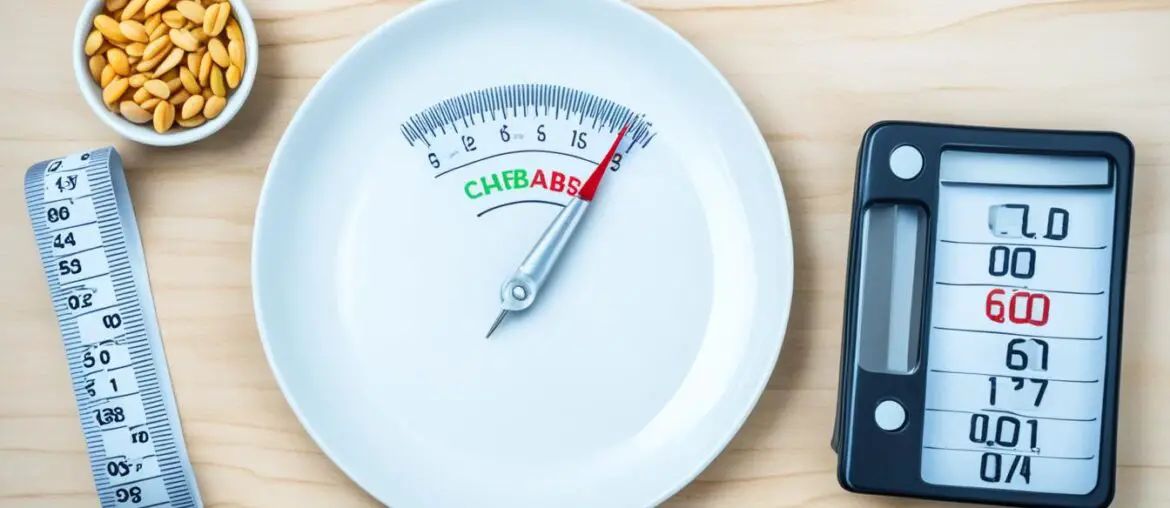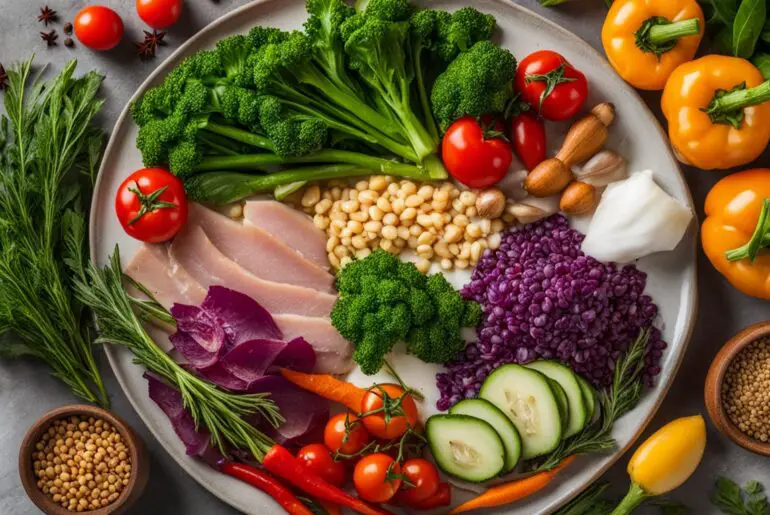Did you know that the HCG diet, a popular weight loss protocol, restricts carbohydrate intake to 500 calories per day during its low-calorie phase?
When you complete the HCG diet, it’s important to gradually reintroduce carbs into your diet for a sustainable and healthy transition to a regular post-diet lifestyle. This process, known as carbohydrate reintegration, plays a crucial role in maintaining weight loss and stabilizing your metabolism.
Key Takeaways:
- After completing the HCG diet, gradually reintroduce carbs into your diet for a sustainable transition.
- Transitioning to a regular diet after the HCG diet is important for maintaining weight loss and avoiding rebound weight gain.
- Focus on making healthy carb choices, such as whole grains, fruits, and vegetables, while limiting refined sugars and processed foods.
- Create a phase 3 meal plan during the maintenance phase of the HCG diet, incorporating a variety of healthy carbs, lean proteins, and vegetables.
- Incorporate exercise into your post-HCG diet routine to maintain weight loss and overall health.
Understanding the HCG Diet Phases
The HCG diet consists of several phases that are essential for successful weight loss and long-term maintenance. These phases include the HCG diet loading phase, HCG diet low-calorie phase, and HCG diet maintenance phase.
HCG Diet Loading Phase
The HCG diet begins with the loading phase, where you consume high-calorie, fatty foods. This phase typically lasts for two days and serves to prepare your body for the low-calorie phase that follows.
During the loading phase, you can indulge in foods like avocados, nuts, cheese, and fatty meats. The purpose is to increase your calorie intake and store energy for the upcoming low-calorie phase.
HCG Diet Low-Calorie Phase
Following the loading phase is the low-calorie phase, where you consume only 500 calories per day. This phase typically lasts for several weeks and is accompanied by daily HCG injections.
During the low-calorie phase, your meals primarily consist of lean proteins, vegetables, and a limited amount of fruits. It is essential to follow the recommended food list and portion sizes to achieve optimal results.
HCG Diet Maintenance Phase
After completing the low-calorie phase, you enter the maintenance phase. This phase aims to help your body adjust to a higher calorie intake and reintroduce a wider variety of food groups, including carbs.
During the maintenance phase, your calorie intake gradually increases, allowing you to personalize your meal plan and incorporate a balanced combination of proteins, fruits, vegetables, and healthy carbs. This phase helps stabilize your weight and maintain the progress achieved during the previous phases.
To better understand the HCG diet and its phases, refer to the following table:
| Phase | Description |
|---|---|
| HCG Diet Loading Phase | Consuming high-calorie, fatty foods to prepare for the low-calorie phase |
| HCG Diet Low-Calorie Phase | Eating only 500 calories per day, primarily consisting of lean proteins, vegetables, and limited fruits |
| HCG Diet Maintenance Phase | Gradually increasing calorie intake and reintroducing a balanced combination of proteins, fruits, vegetables, and healthy carbs |
Understanding the different phases of the HCG diet is crucial for achieving your weight loss goals and maintaining a healthy lifestyle. Each phase serves a specific purpose and allows your body to adjust gradually. By following the recommended guidelines and making informed food choices, you can experience the benefits of the HCG diet and ensure long-term success.
Importance of a Healthy Transition

Transitioning to a regular diet after the HCG diet is crucial for maintaining weight loss and avoiding rebound weight gain. After achieving your desired weight loss goals through the HCG diet, it’s essential to establish a healthy transition plan to ensure long-term success.
A healthy transition involves gradually reintroducing carbs, along with other food groups, into your diet. This gradual reintroduction helps prevent shocking your system and causing metabolic imbalances. By taking a gradual approach, you give your body time to adjust and adapt to the changes, making the transition easier and more sustainable.
One of the key benefits of a healthy transition is that it allows you to maintain the weight loss you achieved during the HCG diet. By gradually reintroducing carbs, you can continue to enjoy the foods you love while still keeping the weight off. This approach also helps prevent the all-too-common rebound weight gain experienced by many after restrictive diets.
In addition to weight maintenance, a healthy transition after the HCG diet supports overall health and wellbeing. By reintroducing a balanced variety of foods, including carbs, you ensure your body receives the nutrients it needs for optimal functioning. This is particularly important considering the potential nutrient deficiencies that may occur during the low-calorie phase of the HCG diet.
My Transition Journey
“After successfully completing the HCG diet, I knew that maintaining the weight loss and transitioning to a regular diet were just as important as the initial phase. I took a gradual approach, slowly reintroducing carbs and other food groups into my meals. This allowed me to strike a balance between enjoying the foods I love and sustaining my weight loss. I also emphasized incorporating whole grains, fruits, and vegetables, which provided me with essential nutrients and fiber. By making mindful choices and practicing portion control, I successfully transitioned to a regular diet while maintaining my weight loss.” – [Your Name]
Remember, a healthy transition is not just about reintroducing carbs—it’s about creating a sustainable and balanced post-diet lifestyle. It’s an opportunity to develop healthier eating habits, prioritize self-care, and make long-term changes that support your overall wellbeing.
To help you visualize the importance of a healthy transition, here is a table summarizing the key benefits:
| Benefits of a Healthy Transition |
|---|
| Maintains weight loss |
| Prevents rebound weight gain |
| Promotes overall health and wellbeing |
| Provides essential nutrients |
| Establishes sustainable eating habits |
| Supports long-term weight maintenance |
Take a moment to reflect on the benefits of a healthy transition. By making gradual changes and ensuring a balanced diet, you can achieve lasting success after the HCG diet.
Next, we’ll explore how to effectively balance your carb intake after the HCG diet and make smart, healthy choices in your post-diet lifestyle.
Balancing Carb Intake After HCG
After completing the HCG diet, it is essential to focus on balancing your carb intake to maintain weight loss and stabilize your metabolism. Incorporating carbs gradually and making smart choices can help prevent rapid weight regain and support a healthy transition to a regular post-diet lifestyle.
During the maintenance phase, when gradually reintroducing carbs into your diet, it is important to practice portion control. By controlling the amount of carbs you consume, you can prevent spikes in blood sugar levels and ensure a balanced approach that aligns with your goals for weight maintenance.
When reintroducing carbs, opt for healthy choices that are rich in nutrients and fiber. Complex carbs, such as whole grains, fruits, and vegetables, should form the foundation of your carbohydrate intake. These sources provide essential vitamins, minerals, and dietary fiber while promoting a feeling of fullness, making them ideal for weight management.
Avoid refined sugars and processed foods as much as possible. These carb sources lack beneficial nutrients and can lead to cravings and energy crashes. Instead, focus on wholesome options that nourish your body and support your overall well-being.
Emphasize variety in your carb choices to ensure a well-rounded diet. Experiment with different whole grains like quinoa, brown rice, and whole wheat pasta. Incorporate a wide range of fruits and vegetables, enjoying their natural sugars along with their many health benefits.
Benefits of Balancing Carb Intake
Gradually reintroducing carbs while balancing your intake offers numerous benefits. Firstly, it helps prevent rapid weight gain by allowing your body to adapt to the higher calorie intake after the low-calorie HCG diet phase.
This gradual approach allows your metabolism to stabilize, reducing the risk of weight fluctuations. It also prevents the body from going into a state of shock, which could hinder weight management efforts.
A balanced carb intake provides sustained energy throughout the day, supporting your daily activities and exercise routine. Complex carbs, in particular, release energy more slowly, preventing energy crashes and promoting satiety.
Additionally, choosing nutrient-dense carb sources supplies your body with essential vitamins, minerals, and fiber. These nutrients help maintain overall health and support proper digestion, ensuring optimal nutrient absorption from other foods.
| Complex Carbs | Refined Carbs | Processed Foods |
|---|---|---|
| Whole grains (brown rice, quinoa, whole wheat bread) | White bread, white rice, sugary cereals | Sugary snacks, chips, packaged meals |
| Source of fiber and essential nutrients | Lacks beneficial nutrients, spikes blood sugar levels | Lacks beneficial nutrients, high in added sugars and unhealthy fats |
| Promotes satiety and balanced energy | May lead to energy crashes and cravings | May lead to cravings and unhealthy eating patterns |
Healthy Carb Choices After HCG

After completing the HCG diet, it is important to make healthy carb choices as you reintroduce this macronutrient back into your meals. By selecting complex carbs that are rich in fiber, essential nutrients, and low in refined sugars, you can maintain a balanced diet and support your post-HCG lifestyle.
Opt for Nutrient-Rich Whole Grains
Whole grains are an excellent choice for incorporating healthy carbs into your diet after the HCG protocol. They are packed with fiber, vitamins, and minerals that support overall health.
“The whole grains provide a steady source of energy and help keep you feeling full for longer periods.”
Choose whole grain options such as brown rice, quinoa, and whole wheat bread. These alternatives offer more nutritional value than their refined counterparts, as they retain the bran, germ, and endosperm of the grain, providing essential vitamins, minerals, and fiber.
Increase Your Fruit and Vegetable Intake
Fruits and vegetables are not only rich in vitamins and minerals but also provide natural sugars and fiber. Including a variety of colorful produce in your meals can enhance the nutritional value and satisfy your carb cravings.
Consider incorporating fruits like berries, oranges, and apples, which are packed with antioxidants and fiber. Vegetables like leafy greens, broccoli, and bell peppers provide essential nutrients such as vitamins A, C, and K, as well as fiber that promotes healthy digestion.
Look for Fiber-Rich Carbs
Fiber is an essential component of a healthy diet and plays a vital role in regulating digestion and maintaining stable blood sugar levels. Including fiber-rich carbs in your meals can help you feel satisfied and support overall gut health.
Choose fiber-rich options like legumes, lentils, and chickpeas. These protein-packed foods also contribute to your daily fiber intake, ensuring a well-rounded and nutritionally dense diet.
By incorporating healthy carb choices like whole grains, fruits, vegetables, and fiber-rich options, you can successfully reintroduce carbs after the HCG diet. These choices provide essential nutrients, fiber, and sustained energy, promoting a balanced and healthy post-diet lifestyle.
Planning Your Phase 3 Meal Plan
Creating a well-thought-out phase 3 meal plan during the maintenance phase of the HCG diet is essential for a successful and sustainable transition. It allows you to reintroduce healthy carbs while ensuring balanced meals that support your weight loss journey. Here’s how you can plan your meals for phase 3:
-
Incorporate a variety of healthy carb options: Include complex carbohydrates such as whole grains, legumes, and starchy vegetables in your meal plan. These provide essential nutrients, fiber, and sustained energy throughout the day. Aim for a mix of different carb sources to keep your meals interesting and nutritionally diverse.
-
Opt for lean proteins: Pair your healthy carbs with lean protein sources like chicken, fish, tofu, or beans. Protein is important for maintaining muscle mass and promoting satiety, ensuring that you feel satisfied and full after each meal.
-
Include plenty of vegetables: Make vegetables the star of your meals by filling half your plate with a variety of colorful options. They are low in calories, high in fiber, and packed with essential vitamins and minerals. They add volume to your meals while keeping them nutritious and satisfying.
-
Distribute carb intake throughout the day: Instead of consuming all your carbs in one meal, spread them out across your day. This helps prevent blood sugar spikes and provides sustained energy levels. Aim for even distribution and consider having carbs with each meal and snack.
-
Focus on portion control: While reintroducing carbs, it’s important to watch your portion sizes. Use measuring cups or a food scale to ensure you’re consuming appropriate portions. This helps prevent overindulgence and supports your weight maintenance goals.
By following these guidelines, you can create balanced and satisfying meals that support your transition to a regular post-HCG diet. Remember to listen to your body, adjust your meal plan as needed, and consult with a healthcare professional or registered dietitian for personalized guidance.
| Meal | Carbohydrate Source | Protein Source | Vegetables |
|---|---|---|---|
| Breakfast | Whole wheat toast | Scrambled eggs | Sautéed spinach and mushrooms |
| Snack | Apple | Plain Greek yogurt | Carrot sticks |
| Lunch | Quinoa | Grilled chicken breast | Mixed greens and cherry tomatoes |
| Snack | Edamame | Almonds | Cucumber slices |
| Dinner | Brown rice | Baked salmon | Steamed broccoli and cauliflower |
This sample meal plan showcases how you can structure your meals, incorporating healthy carb options, lean proteins, and an abundance of vegetables. Feel free to modify it according to your preferences, dietary needs, and calorie requirements. Remember to stay hydrated, listen to your body, and enjoy the journey of nourishing yourself with wholesome foods.
Strategies for a Sustainable Transition

To ensure a sustainable transition after the HCG diet, I recommend implementing the following strategies:
Gradual Reintroduction of Carbs
After completing the HCG diet, it’s important to reintroduce carbs into your diet gradually. This allows your body to adjust and prevents any sudden weight gain. Begin by adding small amounts of complex carbs, such as whole grains and legumes, to your meals. Gradually increase the portion sizes over time, being mindful of your body’s response and adjusting accordingly.
Practicing Portion Control
Portion control plays a vital role in maintaining a healthy weight after the HCG diet. Be mindful of the amount of carbs you consume and ensure they are balanced with other macronutrients. Use measuring cups or a food scale to accurately portion your meals. This will help prevent overeating and promote a sustainable transition to a regular diet.
Mindful Eating
Mindful eating involves paying attention to the cues of hunger and fullness, as well as enjoying and savoring each bite. When reintroducing carbs after the HCG diet, practice mindful eating by listening to your body’s hunger signals and eating until you are satisfied, but not overly full. Avoid distractions such as screens or multitasking while eating, as this can lead to mindless overeating.
“To ensure a sustainable transition after the HCG diet, it is important to implement strategies such as gradual reintroduction of carbs, practicing portion control, and mindful eating.”
Tracking Progress After HCG
Tracking your progress after the HCG diet can help you stay accountable and make any necessary adjustments. Keep a food journal to note your carb intake and portion sizes. Monitor your weight and body measurements regularly to ensure you are maintaining a healthy weight. Additionally, listen to your body’s feedback and make adjustments as needed, such as reducing carbs if you notice any negative effects.
By incorporating these strategies into your post-HCG diet lifestyle, you can ensure a sustainable transition while enjoying the benefits of a balanced and healthy diet.
Incorporating Exercise After HCG

Incorporating exercise after the HCG diet is a crucial step towards maintaining weight loss and overall health. Engaging in regular physical activity not only helps you burn calories but also improves cardiovascular health, boosts mood, and increases energy levels.
To start incorporating exercise into your post-diet fitness routine, it’s important to gradually increase your activity level. Begin with light exercises such as walking, yoga, or swimming, and gradually progress to more intense workouts as your fitness level improves.
Find exercises that you enjoy and that align with your preferences and goals. Choose a variety of activities to keep your routine interesting and prevent boredom. This could include a combination of cardio exercises like running or cycling, strength training exercises using weights or resistance bands, and flexibility exercises like stretching or Pilates.
Acknowledging the importance of maintaining an active lifestyle is key. Strive to find balance and make exercise a regular part of your daily routine. Set realistic goals and schedule dedicated time for physical activity. Consistency is key when it comes to reaping the long-term benefits of exercise.
Remember, exercise after the HCG diet is not only about weight loss but also about promoting a healthy lifestyle. It’s about feeling strong, energized, and taking care of your body.
Additionally, consider incorporating physical activity into your daily life outside of structured workouts. This could include activities such as taking the stairs instead of the elevator, going for a walk during your lunch break, or participating in recreational sports or group fitness classes.
Remember to listen to your body and rest when needed. It’s important to give yourself time to recover and prevent injuries. If you’re unsure about starting an exercise routine, consult with a healthcare professional or a qualified fitness trainer who can guide you and ensure you’re engaging in safe and appropriate exercises.
By incorporating exercise after the HCG diet and maintaining an active lifestyle, you’ll not only support your weight loss efforts but also improve your overall well-being and quality of life.
Benefits of Exercise After HCG
- Helps maintain weight loss by burning calories and increasing metabolism.
- Improves cardiovascular health and lowers the risk of heart disease.
- Boosts mood and reduces stress levels.
- Increases energy levels and improves overall stamina.
- Strengthens muscles and enhances physical performance.
- Promotes bone health and reduces the risk of osteoporosis.
- Improves sleep quality and enhances overall well-being.
Tips for Long-Term Weight Maintenance

Long-term weight maintenance requires adopting healthy habits that promote sustainable lifestyle changes. To ensure lasting success after completing the HCG diet, focus on incorporating the following tips into your daily routine:
1. Establish Sustainable Eating Patterns
Instead of relying on restrictive diets, aim for a well-balanced and varied diet that includes all essential nutrients. Incorporate lean proteins, whole grains, fruits, and vegetables into your meals to fuel your body while maintaining a healthy weight. Practice portion control to avoid overeating and monitor your intake of carbohydrates, proteins, and fats.
2. Engage in Regular Exercise
Physical activity plays a crucial role in maintaining weight loss and overall health. Aim for at least 150 minutes of moderate aerobic activity or 75 minutes of vigorous activity per week. Find activities you enjoy, such as walking, cycling, or dancing, to make exercise a sustainable part of your lifestyle.
3. Manage Stress Effectively
Chronic stress can contribute to weight gain and hinder weight maintenance efforts. Incorporate stress-management techniques into your routine, such as meditation, deep breathing exercises, or engaging in hobbies that relax you. Prioritize self-care activities to promote overall well-being and reduce emotional eating.
4. Seek Support and Accountability
Develop strategies to handle challenges and setbacks along your weight maintenance journey. Surround yourself with a strong support system of family, friends, or professionals who can provide guidance and encouragement. Consider joining support groups or online communities where you can share your experiences and receive support from individuals facing similar challenges.
“Success is the sum of small efforts repeated day in and day out.” – Robert Collier
5. Track Your Progress
Maintain a record of your food intake, exercise routine, and emotions to identify patterns and triggers related to weight management. Tracking your progress can help you stay accountable and make necessary adjustments to ensure long-term success.
6. Prioritize Ongoing Self-Care
Make self-care a priority to support your physical and mental well-being. Engage in activities that bring you joy, practice mindfulness, and get enough sleep. Nurturing your body and mind will help you maintain a positive mindset and stay motivated on your weight maintenance journey.
| Tips for Long-Term Weight Maintenance | Summary |
|---|---|
| Establish Sustainable Eating Patterns | Focus on a balanced diet with lean proteins, whole grains, fruits, and vegetables. Practice portion control. |
| Engage in Regular Exercise | Aim for at least 150 minutes of moderate aerobic activity or 75 minutes of vigorous activity per week. |
| Manage Stress Effectively | Incorporate stress-management techniques into your routine. Prioritize self-care activities. |
| Seek Support and Accountability | Surround yourself with a strong support system and consider joining support groups. |
| Track Your Progress | Maintain a record of your food intake, exercise routine, and emotions to identify patterns and triggers. |
| Prioritize Ongoing Self-Care | Engage in activities that bring you joy, practice mindfulness, and get enough sleep. |
Conclusion
Incorporating carbs after the HCG diet can be achieved in a healthy and sustainable manner by gradually reintroducing carbs into your meals, making smart carb choices, and practicing portion control. It is essential to maintain a long-term focus on weight maintenance and adopt a balanced and healthy lifestyle. By implementing the right strategies and habits, you can achieve lasting success after completing the HCG diet.
During the maintenance phase, gradually reintroduce carbs into your diet to avoid shocking your system. Focus on choosing complex carbs such as whole grains, fruits, and vegetables, which provide essential nutrients and fiber. Limit refined sugars and processed foods to maintain a well-balanced diet.
Remember, incorporating carbs after the HCG diet is not a return to old eating habits. It is an opportunity to continue making healthy choices and maintain the progress you have achieved. By staying mindful of portion sizes and incorporating regular exercise, you can successfully transition into a post-diet lifestyle and enjoy the many benefits of a balanced and sustainable diet.
FAQ
What is the HCG diet?
The HCG diet is a weight loss protocol developed by Dr. A.T.W. Simeons. It consists of multiple phases, including a loading phase, a low-calorie phase, and a maintenance phase.
How do I transition to a regular diet after the HCG diet?
After completing the HCG diet, it is important to gradually reintroduce carbs into your diet for a sustainable and healthy transition. This helps maintain weight loss and avoid rebound weight gain.
How do I balance carb intake after the HCG diet?
Balancing carb intake after the HCG diet involves gradually reintroducing carbs into your diet while maintaining portion control and choosing healthy carb sources. This helps prevent rapid weight regain and stabilize your metabolism.
What are some healthy carb choices after the HCG diet?
After the HCG diet, it is important to choose healthy carb sources that provide essential nutrients and fiber. Opt for whole grains, such as brown rice, quinoa, and whole wheat bread. Include plenty of fruits and vegetables in your diet for natural sugars and fiber.
How do I plan my phase 3 meal plan during the maintenance phase of the HCG diet?
Creating a phase 3 meal plan during the maintenance phase of the HCG diet is essential for a successful transition. Plan meals that include a variety of healthy carbs, lean proteins, and vegetables. Distribute your carb intake throughout the day and focus on portion control.
What strategies can I implement for a sustainable transition after the HCG diet?
To ensure a sustainable transition after the HCG diet, it is important to implement strategies such as gradual reintroduction of carbs, practicing portion control, and mindful eating. Tracking your progress and maintaining a healthy lifestyle will help prevent weight regain and ensure long-term success.
Should I incorporate exercise after the HCG diet?
Incorporating exercise after the HCG diet is essential for maintaining weight loss and overall health. Gradually increase your activity level and choose exercises that you enjoy. Find a post-diet fitness routine that works for you and strive to maintain an active lifestyle for long-term success.
What tips can you provide for long-term weight maintenance after the HCG diet?
Long-term weight maintenance requires adopting healthy habits and making lifestyle changes. Focus on sustainable eating patterns, regular exercise, stress management, and self-care. Develop strategies to handle challenges and setbacks, and seek support from professionals or support groups to help you stay on track.
How can I incorporate carbs after the HCG diet in a healthy way?
Incorporating carbs after the HCG diet can be done in a healthy and sustainable way by gradually reintroducing carbs, making smart carb choices, and practicing portion control. Focus on long-term weight maintenance and adopt a balanced and healthy lifestyle for lasting success after the HCG diet.




